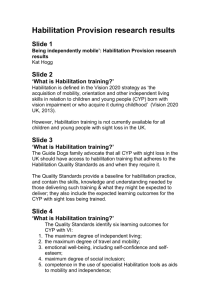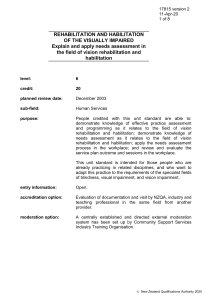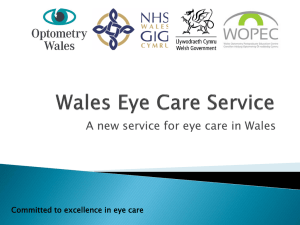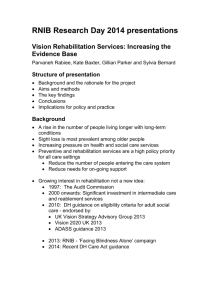Growing up and Moving On - Wales Council for the Blind
advertisement
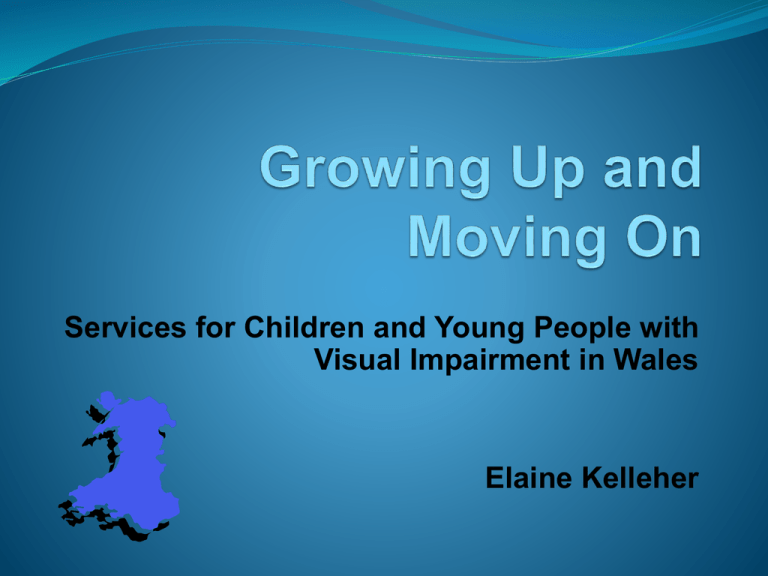
Services for Children and Young People with Visual Impairment in Wales Elaine Kelleher Introduction Children and young people with visual impairment may have good academic skills but lack the independence and life skills to move into the world of further/higher education or workplace Objectives What specialist VI services are in place for children and young people in each authority in Wales How specialist VI services are addressing the mobility, independent living and social skills needs of children and young people, and to what extent Provide recommendations based on findings Habilitation : mobility and independent living skills training for children, recognises the distinct needs of children with VI learning new skills as apposed to Rehabilitation with adults, where the emphasis is on regaining skills. Age range 0-19 years A total of approx 1,500 children and young people were supported by VI Services in Local Education Authorities across Wales in 2011/12 Methods Interviews with: Qualified Teachers for the Visually Impaired (QTVIs) Mobility Specialists Rehabilitation Officers Visual Impairment (ROVIs) Social Workers VI Third Sector (RNIB Cymru, North Wales Society for the Blind, Vision Support, Sight Support, Cardiff Vale and Valleys) Parents and young people Delivery of Mobility Services in Education 1. 18 Authorities employ Mobility Specialists directly in education 2. In the other 4 Authorities Rehabilitation Officers VI in social care provide mobility and independence skills in education Delivery of Habilitation Services in Social Services In 12 authorities Rehabilitation Officers VI provide habilitation for children as well as Rehabilitation for adults In other 10 authorities Rehabilitation Officers VI work with adults only Concerns In 5 authorities, no contact is made by a specialist VI worker (in adult or children services) following receipt of Certificate of Visual Impairment Transition to Adulthood VI-specific social groups Communication between services Examples of Good Practice Collaborative Working - termly meetings between social services (Sensory Team and Disabled Children’s Team) and VI service in education to discuss children’s needs and plan future intervention Mobility Officer in Education provides a mobility report to Rehabilitation Officer VI in social care on leaving educational placement Recommendations Habilitation: Every VI child and young person in Wales should have access to a full habilitation service. In the current model of service provision, habilitation service needs to be improved as follows: i. An increase in mobility services in education to ensure that every VI child and young person should have an assessment of their mobility needs. ii. The creation of a Rehabilitation / Habilitation Officer post for children and young people on a regional level to provide a service in the authorities where there is no service provision (10 authorities in Wales). Further Recommendations Transition: Creation of a Transitions Officer for VI post based in North Wales to provide a similar level of support for children and young people as that provided in South Wales. Links need to be made at an early stage between VI services in education and Rehabilitation services in Adult Social Care to ensure the young person is aware of services available to them. Where habilitation services for VI children and young people don’t currently exist, improvement of the transition to adulthood process is required by prioritising the needs of visually impaired young people by Adult VI services. Other: Creation of regular VI-specific social groups for children and young people in each region. Highlight the findings regarding registration with Eye Clinic Liaison Officers (ECLOs). Equip ECLOs with information on entitlements of registration for children and young people and information on statutory and third sector services available in each authority. Where habilitation services currently exist for VI children and young people, VI specialists in education and social care need to meet regularly to discuss the needs and plan service intervention to provide continuity and improve outcomes for VI children and young people. Capitalise on resources already in place. Working together to improve communication and partnerships, especially between education and social services leading to multiagency working with young VI people ultimately achieving their potential for an independent life.




